Somehow, what the low angled light of October does to grasses always catches me by surprise. I caught this peripheral shimmer on the way to the office yesterday morning, turned to find the source and gasped. Of course it’s one of the reasons I love these big grasses, but it’s been hot and weird lately and expecting revelatory moments from the garden in the morning is not top of mind as I head to the office to check the news. But with the sun sweeping low, these fountains of light are once again enthralling.
This is the first year I’ve had Muhlenbergia lindheimeri flowering in the garden, and I’m completely infatuated with its slim spikes of bloom beginning in September. To its left is Miscanthus ‘Silver Sceptre’ which begins bloom in early summer. The early morning dew acts as a pomade on the miscanthus and slicks down the frizzy, months’ old blooms, but as the day progresses they fuzz out again. Kind of a charming performance, and more attractive on a plant than my big mop of hair that hasn’t had a haircut since lockdown.
From the back wall of the garden looking east, past the Aloe ferox hybrid, at the dessicated state of the tetrapanax, a state of dishevelment it’s always in by end of summer. In colder zones the rice paper plants are gloriously lush by summer’s end right up to the first frost. In autumn in my zone 10, the tetrapanax will shake off the summer doldrums and throw antler-like blooms in November/December. Melianthus is another “foliage” plant that’s almost leafless by September and just showing new growth in October. Ditto for the sonchus tribe. Bocconia never loses its cool and looks good all summer but does drop more leaves on hot days. Melianthus ‘Purple Haze’ strikes me as even less capable than the species of gracefully tolerating summer’s stress test.
With the laundry shed doors wide open — nice! — another look at the trunks of the tetrapanax and its wizened leaves. I doubt I’ll ever see a Yucca rostrata form a trunk in my lifetime — they are sooo slooow in low rainfall climates, but this stage is gorgeous enough.* Alcantarea imperialis to its left. Heuchera maxima to the right of the brom was added earlier this year, a ‘Tara’ hedychium was moved back here with castor beans, and there’s generally been a lot more planting in this corner under the acacia now that a hose easily reaches. Yesterday Ageratum corymbosum was planted, part of an order from Annie’s Annuals, and Lobelia tupa is getting another tryout here too. There’s strong morning sun here with bright cool sun the rest of the day in summer. Lobelia tupa fried in full sun in previous attempts.*
A big surprise has been the fortitude of umbellifer Peucedanum verticillare, the celery-like leaves mid photo above. Not known as a zone 10 plant, its health and lust for life at the end of summer bodes well for possible bloom next spring. Also here is the summer-dormant giant fennel, Ferula communis, which showed uncharacteristic leafy growth in August. I’m not sure what to make of this performance but have decided to give it a little more water to reward the effort. At this point it’s all guesswork. (Dan Pearson wrote an account of it in bloom this year in his English garden for those unfamiliar with this giant umbellifer from Greece.)
The self-sown castor beans under the acacia have been really good this summer. I finally “got religion” about pinching and cutting off the flower buds that always form before the plants get a chance to make some leafy structure, and they are obviously much better for it. Tall, well branched, big leaves.
The seed report, summer 2020. The many varieties of cosmos sown in late June did not readily take to life in pots. I must not be throwing on enough seaweed fertilizer because there are plenty of anecdotal accounts online of cosmos loving containers. I won’t be trying that again, but it was fun to mother hen the seedlings during lockdown. Zinnias were not easy in pots either. And I think I’m done with Rudbeckia triloba now that I’ve found Cosmos sulphureus, much longer blooming and more tolerant of drier conditions among the succulents.
Celosia ‘Cramer’s Amazon’ planted from 4-inch pots in August is flourishing in one of the hottest parts of the garden. The same celosia planted in dappled sun is a pitiful thing, so handling the hot months of September and October here is definitely in this celosia’s wheelhouse. Wednesday this past week snuck up to 105. Forecast was high 90’s, but by 10 a.m. the heat was increasing with a speed I can only liken to a heat storm, if there is such a phenomenon. The sarracenia/pitcher plants were toasted before I could move them to shade, and by 10 a.m. it was apparent that the succulents in pots against the house that have been staged there all summer would not survive the day if left in place. (The pitcher plants will recover but the blooms were fried.)
The LA Times has a list of native plant sales going forward this fall here — where you might be able to find Muhlenbergia lindheimeri if you’re interested or that flannel bush you’ve been dying to grow. If we ever get the wooden fence torn down and the new one up, I’m going to be needing a flannel bush myself. They grow as espaliers, right? The side gate has finally been finished, and no termite will ever feast on it again because it’s metal. So there. More on that soon.
I know it’s been a rough week, but don’t let the bastards get you down! Stay safe and for the best revenge, have a great weekend.
(Edited 10/19/20: Lobelia tupa 2020 shriveled up in the recent heat wave, and in dappled sun! I think that’s a definitive trial. The last of three to survive, a Verbascum bombyciferum also crumpled and melted from the heat. One of the lemon cypresses was removed over the weekend, and the first cut came crashing down on aforementioned, very slow-growing Yucca rostrata. Marty jumped in and removed the branch within seconds, and no further debris came down on the garden. There was some crimping of the yucca’s leaves but it seems to be shaking off the assault. The light sweeping in from the east with the third cypress gone is revelatory. Pondering a post on planting for privacy in a very small garden, at the property lines, and how we all make a hash out of it. My neighbor is afraid of my cypresses, I’m afraid of their pepper tree, etc., but so far we’re all dealing with it amiably.)



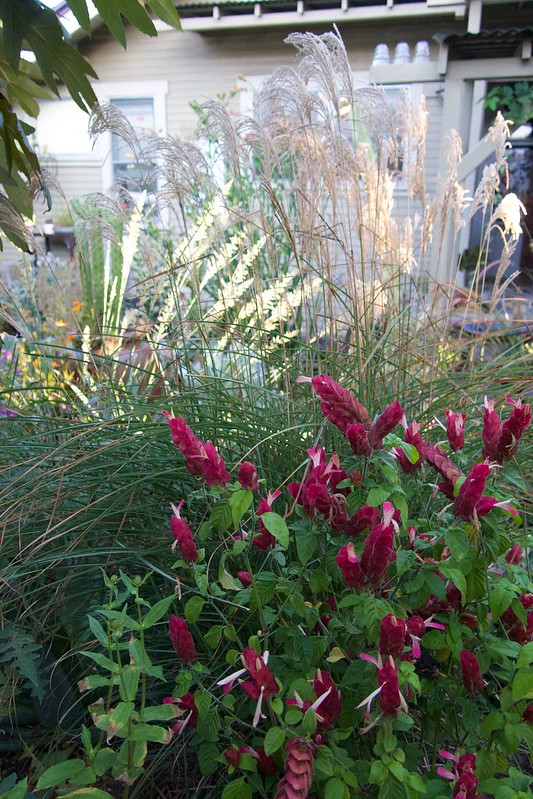



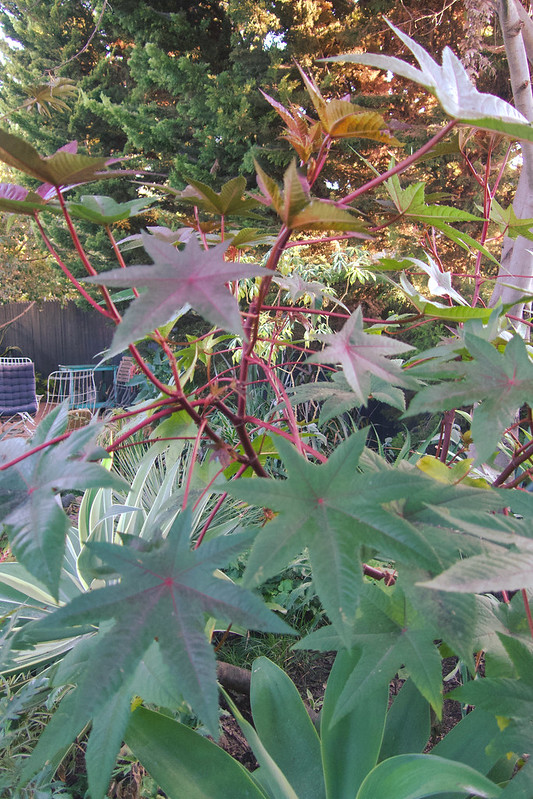

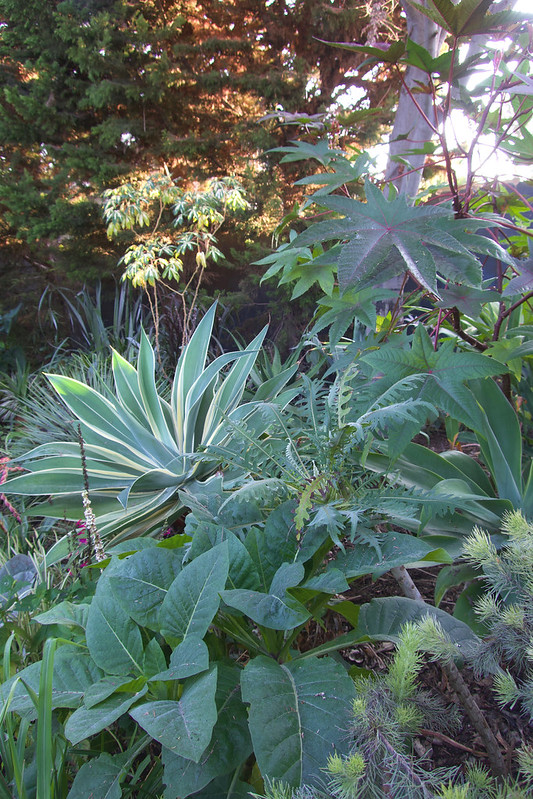

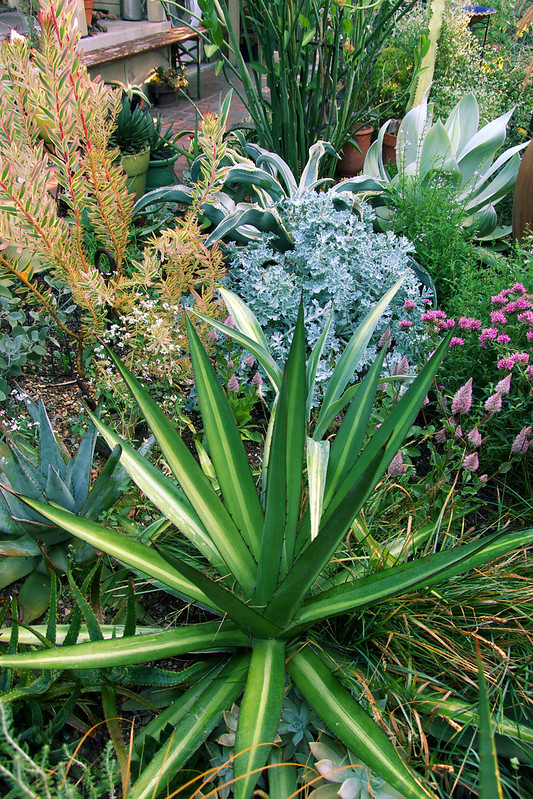
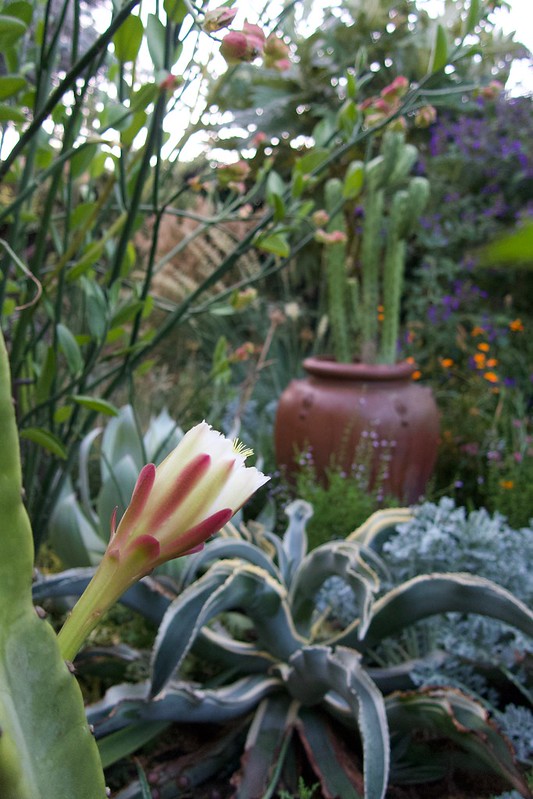
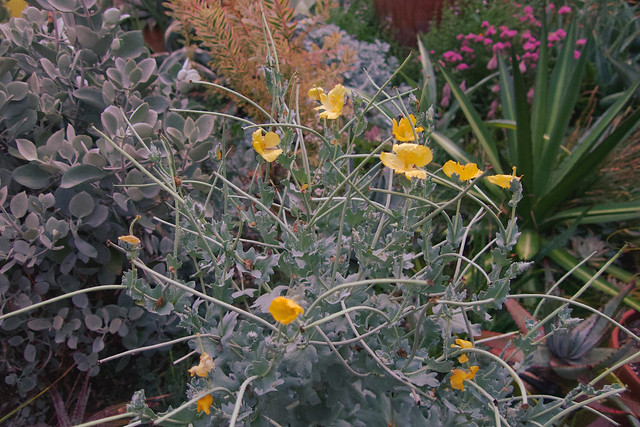
105! Your temperature was higher than ours, which peaked at 102 but didn’t stay there long. Still, after the earlier heatwave, I’m worn down, even though the deep waterings I’ve given my garden in advance of the heatwaves made a material difference this year. I had a similar response, or I should say non-response, from the Cosmos seeds I sowed late this year. My Melianthus also pooped out. However, your success with plants like Salvia mexicana never ceases to impress and amaze me as the Salvia from that part of the world and further south hate my garden.
Despite all the heat your garden looks remarkably good after all it’s been through. The bromeliad especially looks unfazed by the heat. Even in my cooler climate I struggle with cosmos. I finally gave up even though in other gardens it acts like a weed.
October is inventory time at Statler Toyota, and this is a great inventory of many of your very choice plants.
Adenanthos sericeus there? Looks so lovely. Tempts me to try it one more time. ‘Ray of Light’, the Alcanterea, the shrimp plant, all gems in the October light.
Yeah, that heat was like someone opened Hell’s oven. Nasty.
A gorgeous photo essay of time and place.
I’ve taken to reading, and re-reading, you posts before going out in the morning to do battle with the landscape. Your post and pictures provide inspiration tinged with just the right amount of envy.
It has also been hot here along the Central Coast, and more days than anyone can remember when the temperature went above one hundred degrees. There are scorched agaves and tomatoes with sun scald everywhere Tomatoes with sun scaled in foggy Carmel Valley, unbelievable.